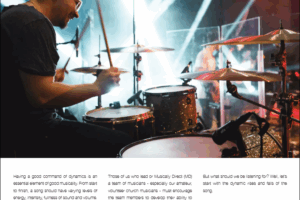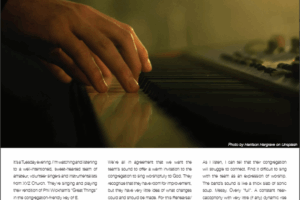Take this link to read Grant’s article as featured in the July issue of Worship…

MIC TECHNIQUE FOR VOCALISTS: FRUSTRATED? WHY?
By Grant Norsworthy
Poor mic technique is a constant source of frustration for many Church audio techs. But this is NOT (yet another) article that explains what correct mic technique is. Instead, it’s an article that suggests ways to stop the constant frustration.
(But if you need some tips about better mic technique, check out this short video I made on the subject).
Audio techs know what constitutes good and bad mic technique. We know the difficulties that bad mic technique brings to the mixing console and, ultimately, our ears and the ears of the congregation. We know how much easier everything gets when our singers have great mic technique.
Even though any good Musical Director (MD) or audio tech has explained and even shown singers good mic technique (probably more than once), why does the frustration-generating poor mic technique continue?
My Theory: In the same way that many – especially less experienced – singers do not yet know how to use a microphone correctly, many audio techs and musical directors (MDs) do not yet know how to teach singers correct mic technique.
“I’ve showed them over and over again how to hold the mic, but it makes no difference!”
I hear comments like this over and over again from audio techs and MDs when I give one of my More Than Music Mentor training workshops for worshiping musicians. But here’s the breakdown:
Simply communicating information is NOT teaching.
Teaching has not occurred unless learning has occurred.
A teacher cannot assume that learning has occurred unless it is demonstrated by behavioral change.
The MD or audio tech may have conveyed the information about good mic technique, but they have not yet actually taught it. It has not been learned and the learning is not being demonstrated. While mic technique might improve for a period of time – between 8 bars and a song and a half – the mic technique of the singers quickly slips back to the preexisting, less-than-ideal bad practices. Many MDs and audio techs have stopped trying because simply telling doesn’t change anything.
So what’s missing that could transform this communication of information into teaching – teaching that brings about learning and lasting, demonstrated change?
While many have told their singer the “what” and “how” of mic technique, rarely do they explain WHY. Few give the singers a physical demonstration that allows them to experience WHY mic technique is so important.
We need to realize that the “what” and “how” of good mic technique (or anything else for that matter) only make sense when we understand and appreciate why.
I must confess that my ways of teaching correct mic technique do not have a 100% success rate. I am pleased, however, with the frequent, surprised-yet-thankful responses I get – especially from audio techs – when they see (and hear) a marked improvement in this area: Improvement that lasts – not just for the sound check and rehearsal – but through a full weekend of services and beyond.
I think there are just a few things I do – all designed to emphasize the WHY – that help bring about higher success rates:
- Explaining WHY
It might seem too obvious, but I like to make it absolutely clear to the singers that their job is to invite the congregation to sing along with them! In my opinion, no other single thing encourages an individual congregation member to sing more than the sense that other people are already singing. By delivering a good, clear, consistent vocal performance through the microphone, our leading vocalists can roll out a metaphorical red carpet to the congregation that warmly draws them to find their own “voice” to sing prayers to God, praises of God and declarations of truth about God.
To give the congregation the confidence to sing – to give them the nudge that they need – we must make it easy for them to hear how the song goes – especially the words and the melody. We must show them that they too can and should sing. Why good mic technique? Because without it, the congregation will be less likely and less able to sing. - Demonstrating WHY
Being sure that there are no competing sounds or other distractions, I have found it really helpful to let the singers hear how radically different the amplified human voice sounds as the position of the mic changes in relation to the sound source. With the PA on, in-ear monitors (IEMs) out (this works even better with open speaker monitors left on) and starting with good mic position and grip, I begin singing a familiar song. While delivering a consistent vocal performance, I will move the mic through a range of less-than-ideal angle and distance positions in relation to my mouth. I might add some “cabaret” mic posing or even the dreaded gangsta rapper “cupped” grip for good effect before returning to the correct position. Exaggeration helps.
Then I’ll ask the team what they heard. If I’ve done it right, the demonstration is very convincing. I love seeing the widening eye and nodding heads of singers who, until that moment, had never realized why good mic technique was essential to good vocal sound. - Experiencing WHY … in context
The final, and most potent way to help the singers develop better mic technique is for them to hear the benefits for themselves with their own voice. But to give them that experience they’ll need to have a good monitor mix and know how to listen to their own vocal performance in the context of the whole ensemble’s sound.
To teach about setting monitors and how to listen, I love having the vocal line (3 to 5 singers, each with their own mic and sharing a single, old-school, open-speaker monitor mix) work through a simple-yet-highly-effective exercise. Without any instruments playing and with FOH off for the moment, we stand in a curved line, all at an equal distance from the speakers. First, I’ll sing a familiar chorus and have the audio tech help with level and EQ adjustments to achieve what I consider a natural sounding, as-low-in-level-as-I-can-stand-it, inspiring monitor sound.
Next – and making sure that mic technique is on point – we do the same with a second singer. Once their monitor is set, we sing the same chorus together – melody only. We work to set an even blend of our voices. If one voice is difficult to make out, we tend not to turn it up. We turn the louder voice down.
One at a time we add each voice, all the while emphasizing the, “You don’t need to hear just yourself, you need to just hear yourself” monitor mantra. It can be quite the balancing act, but, if you do it right, achieving that blend of voices is inspiring and gives each singer a heightened awareness of how important it is to deliver a consistent signal and how little variation in mic placement negative effect the blend. To ice the cake, we can break into some well-rehearsed harmonies with the PA switched on.
NOTE: If open speaker monitors are not available, this exercise can be done using one, shared IEM mix. Perhaps better than that would be to have the singers stand on the floor and use the PA as a big monitor.
While the evenly blended mix of this exercise may not be exactly what we end up with for monitors, the concept of listening – REALLY listening to each other and how each singer’s voice fits within the overall sound – gives experiences that will ultimately improve mic technique as well.
The main reason a singer will drop their mic out of the ideal position is that they are unaware that it has made any difference! They cannot tell why they shouldn’t. They’re singing, but with no sense how their piece fits into the sonic jigsaw. Either their monitor mix is so confused that it feels like they’re singing into a vat of sonic soup, or they have not yet learned what they should be listening for, or both. Audio techs and MDs may need to step in and help in these areas too. Mic technique is merely one link in a much longer chain.
Most of our amateur, volunteer vocalists with poor mic technique have only limited experience. Asking them to sing into a microphone may fill them with dread! They’re already feeling overloaded and on the very front edge of their ability – maybe beyond their ability. They’ll need to be taught the correct technique by a teacher who is more like an elementary school teacher than a university professor.
What’s the difference between teaching at university level and at elementary school level?
A university professor will make information available to the students but, if learning doesn’t occur, it’s pretty much the students’ fault. It’s up to the students to put in the work so that they grow in their understanding and competence.
In elementary school, however, if the students aren’t learning, it’s on the teacher. The teacher has to meet the children where they are at – must give them a set of experiences that brings about learning. The kids are still learning to learn! If any student is not learning, it’s up to the teacher to teach the same material, but in a different way, until each student can learn. Any good elementary school teacher knows this: experience teaches far better than words alone.
Rather than giving up or just conveying the information out of frustration, let’s teach with patience and kindness. Create opportunities for our singers to experience the “why” of good mic technique, so that the “what” and the “how” will flow more easily from there.
This article was first published by Worship Tech Director of the WFX Network on October 18, 2019.


